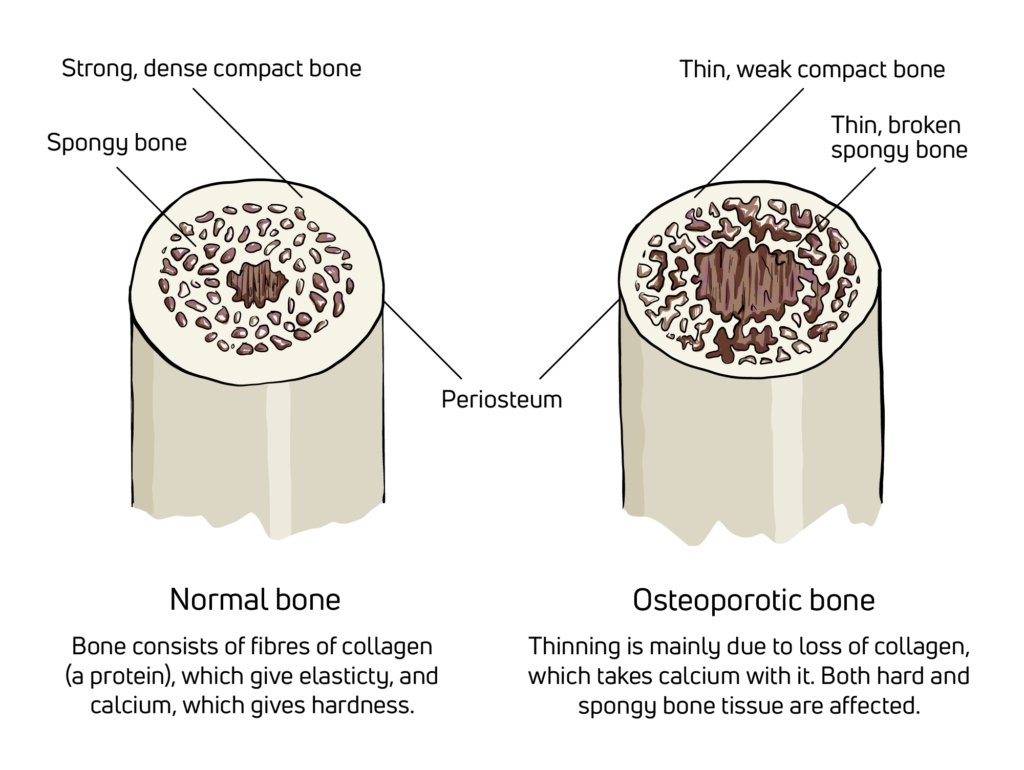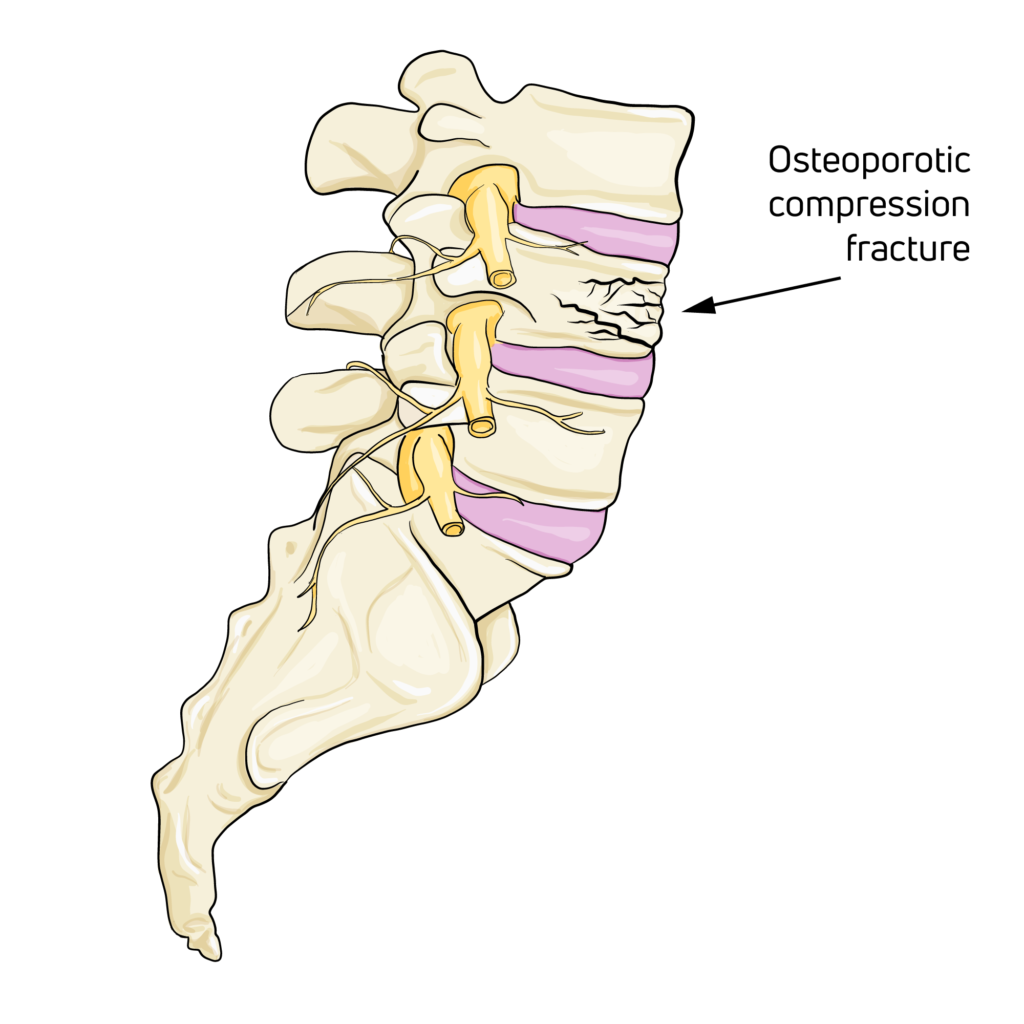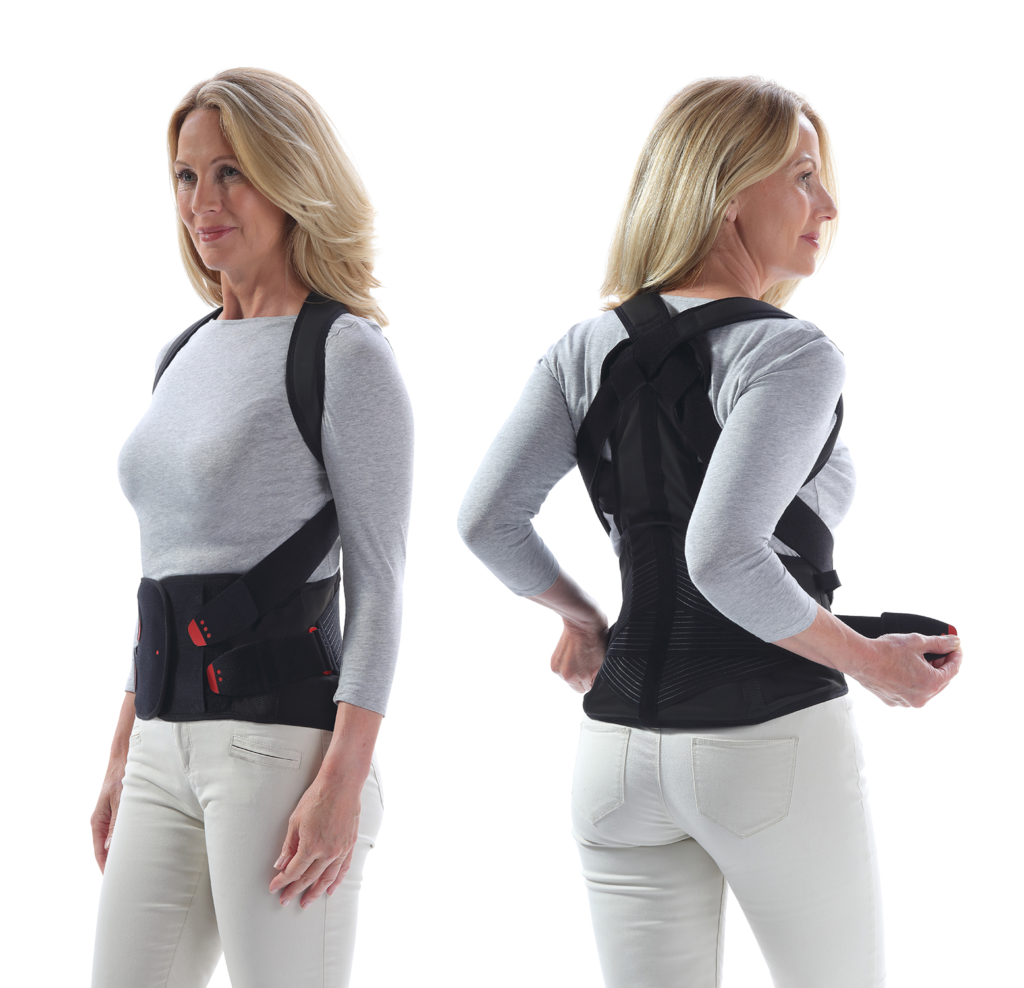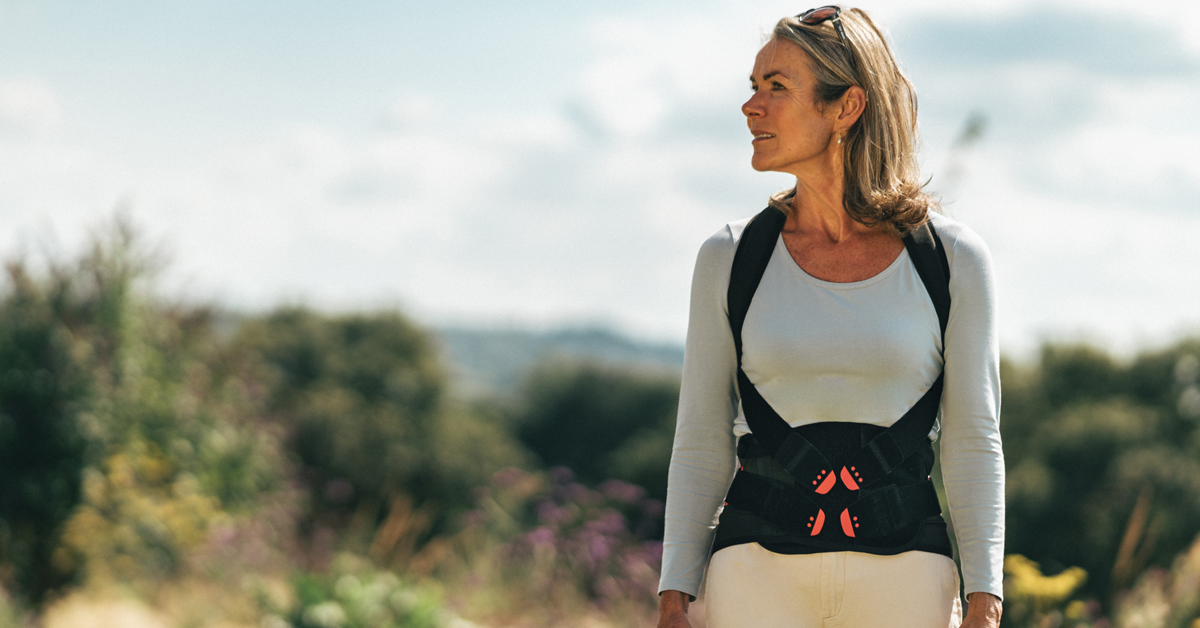Osteoporosis is a progressive condition that weakens bones, making them fragile and more likely to break.
As a result of this loss of bone, many osteoporosis patients will also suffer spinal compression fractures, with 1.4 million new clinical vertebral fractures reported in the year 2000.1 Such fractures can have a serious impact on a person’s ability to maintain an active lifestyle, with pain and a loss of confidence presenting two formidable challenges to overcome.
One therapeutic option available to osteoporotic patients is semi-rigid back bracing. These kinds of medical orthoses are designed to alleviate the symptoms of vertebral osteoporosis and help patients stay active, but what evidence is there that a back brace can help patients with osteoporosis?
What causes osteoporosis?
Bone naturally becomes thinner as a person ages, but women are especially vulnerable to osteoporosis after the menopause because their ovaries no longer produce oestrogen hormones which help maintain bone mass. Around 200 million women worldwide are estimated to be affected by osteoporosis.2
Other causes of osteoporosis are:
- Removal of the ovaries
- A diet lacking sufficient calcium
- Certain hormonal disorders
- Prolonged use of corticosteroid drugs
- Prolonged immobility
Osteoporosis is also more common in heavy smokers and drinkers.
What are the symptoms and signs of osteoporosis?
The first sign of osteoporosis is often a fracture caused by a fall that would not result in a fracture in a young adult. Typical sites for such fractures are the wrist and the top of the femur.
Another type of fracture that occurs in osteoporosis is a spontaneous fracture of one or several vertebrae, which causes the bones to crumble, leading to a progressive loss of height or to pain due to compression of a spinal nerve.
What are spinal compression fractures, and how are they treated?
Spinal compression fractures occur when the combined axial and bending loads on the spine exceed the strength of the vertebral body, resulting in the collapse of the vertebrae.
These fractures are associated with back pain and disability, loss of height, and kyphosis – a spinal disorder in which excessive curving of the spine results in an exaggerated forward rounding of the upper back.3,4,5
Spinal compression fractures involving the anterior elements of the spinal column are considered stable fractures and most patients remain neurologically intact.5,6
Once a diagnosis is confirmed, the first line of treatment is typically conservative pain management, usually involving some form of bracing or physiotherapy.5,6
Some patients who fail conservative treatment may require hospitalization, long term care, and surgical interventions such as percutaneous vertebroplasty and balloon kyphoplasty.5,6
How can bracing help osteoporosis patients?
Orthopedic back braces designed for the management of osteoporosis symptoms should perform some or all of the following functions:
- Control pain by limiting motion7
- Stabilize injured structures by immobilizing the spine7
- Provide pressure to promote correction and prevent deformity7
- Reduce pain and fatigue8
- Promote function or participation8
Of the different types, semi-rigid back braces seem to be the most effective, with good clinical evidence supporting their use for osteoporotic patients.
In 2011, Jacobs et al. demonstrated that using a semi-rigid thoracolumbar orthosis seems to have a positive effect on gait and stability in patients suffering from an osteoporotic spinal compression fracture.9
In the same year, a study by Pfeifer et al. showed that the use of a semi-rigid orthosis increases trunk muscle strength and therefore improves posture in patients with vertebral fractures caused by osteoporosis.10
In Dionyssiotis et al.’s 2015 study, they showed that semi-rigid orthoses could be an effective intervention for improving back pain and muscle strength in osteoporotic women.11
And Meccariello et al. (2017) demonstrated that a semi-rigid orthosis proved to be safe and effective in the treatment of thoracolumbar osteoporotic vertebral fracture, with better functional outcome and less complications compared to a standard rigid 3-point orthosis.12
Introducing DonJoy® Osteostrap – a new back brace for osteoporosis
With its innovative modular design, DonJoy® Osteostrap utilizes a set of adjustable features to aid active relief and postural correction of the thoracic spine.
The brace’s reverse shoulder straps, semi-rigid dorsal frame, and lumbar belt combine to provide patient-specific support and correction of kyphotic posture through active relief and stabilization of the spine. The brace is easy to self-fit, and its intuitive fixtures remain within easy reach for hassle-free adjustment.
Comprised of two separate sections, the brace allows 15 combinations of different lumbar belt and dorsal frame sizes to accommodate spine lengths from C7-S1, as well as waist circumferences from 56 – 130 cm.
Soft, elastic, breathable materials help provide a comfortable fit, allowing extended periods of wear and encouraging patient compliance. Also, the brace’s low-profile shape allows the wearer to maintain freedom of movement while remaining supportive.
User-friendly, comfortable, and available in a wide range of sizes, DonJoy Osteostrap offers patients suffering from osteoporosis and other debilitating back conditions the support they need to help live a normal, active life.
Learn more about DonJoy Osteostrap here.
References
- Johnell, O., & Kanis, J. A. (2006). An estimate of the worldwide prevalence and disability associated with osteoporotic fractures. Osteoporosis international : a journal established as result of cooperation between the European Foundation for Osteoporosis and the National Osteoporosis Foundation of the USA, 17(12), 1726–1733.
- Reginster, J. Y., & Burlet, N. (2006). Osteoporosis: a still increasing prevalence. Bone, 38(2 Suppl 1), S4–S9.
- Mathis, J.M., Barr, J.D., Belkoff, S.M., Barr, M.S., Jensen, M.E. and Deramond, H., 2001. Percutaneous vertebroplasty: a developing standard of care for vertebral compression fractures. American journal of neuroradiology, 22(2), pp.373-381.
- Burge, R., Dawson-Hughes, B., Solomon, D.H., Wong, J.B., King, A. and Tosteson, A., 2007. Incidence and economic burden of osteoporosis‐related fractures in the United States, 2005–2025. Journal of bone and mineral research, 22(3), pp.465-475.
- Genant, H.K., Cooper, C., Poor, G., Reid, I., Ehrlich, G., Kanis, J., Nordin, B.C., Barrett-Connor, E., Black, D., Bonjour, J.P. and Dawson-Hughes, B., 1999. Interim report and recommendations of the World Health Organization task-force for osteoporosis. Osteoporosis international, 10(4), p.259.
- Kanis, J.A., 1999. The burden of osteoporosis. Journal of endocrinological investigation, 22(8), pp.583-588.
- Kato, T., Inose, H., Ichimura, S., Tokuhashi, Y., Nakamura, H., Hoshino, M., Togawa, D., Hirano, T., Haro, H., Ohba, T., Tsuji, T., Sato, K., Sasao, Y., Takahata, M., Otani, K., Momoshima, S., Tateishi, U., Tomita, M., Takemasa, R., Yuasa, M., … Okawa, A. (2019). Comparison of Rigid and Soft- Brace Treatments for Acute Osteoporotic Vertebral Compression Fracture: A Prospective, Randomized, Multicenter Study. Journal of clinical medicine, 8(2), 198.
- Newman, M., Lowe, C.M. and Barker, K., 2016. Spinal orthoses for vertebral osteoporosis and osteoporotic vertebral fracture: a systematic review. Archives of physical medicine and rehabilitation, 97(6), pp.1013-1025.
- Jacobs, E., Senden, R., McCrum, C., van Rhijn, L. W., Meijer, K., & Willems, P. C. (2019). Effect of a semirigid thoracolumbar orthosis on gait and sagittal alignment in patients with an osteoporotic vertebral compression fracture. Clinical interventions in aging, 14, 671–680.
- Pfeifer, M., Kohlwey, L., Begerow, B., & Minne, H. W. (2011). Effects of two newly developed spinal orthoses on trunk muscle strength, posture, and quality-of-life in women with postmenopausal osteoporosis: a randomized trial. American journal of physical medicine & rehabilitation, 90(10), 805–815.
- Dionyssiotis, Y., Trovas, G., Thoma, S., Lyritis, G., & Papaioannou, N. (2015). Prospective study of spinal orthoses in women. Prosthetics and orthotics international, 39(6), 487–495.
- Meccariello, L., Muzii, V. F., Falzarano, G., Medici, A., Carta, S., Fortina, M., & Ferrata, P. (2017). Dynamic corset versus three-point brace in the treatment of osteoporotic compression fractures of the thoracic and lumbar spine: a prospective, comparative study. Aging clinical and experimental research, 29(3), 443–449.












